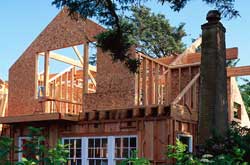It's Easy Being Green with Green Remodeling
See if We Have Top-Rated
Remodeling Contractors in Your Area

Today, residential green remodeling is more popular than ever. While commercial and industrial building are also concerned with green remodeling, residential construction is truly beginning to embrace the eco-friendly and renewable resources that are making new homes more energy efficient inside and out. If you are in the market for a new kitchen, bathroom, or even a whole new house, there are many ways to make your project more efficient, less wasteful, more valuable, and even safer for you and your family!
Residential Green Remodeling: The Idea
While a big part of residential green remodeling is a matter of choosing efficient appliances and using recycled or renewable materials during construction, professional green builders know that there's much more to it. Instead of simply swapping older components with newer, greener ones, green builders try to focus on the house as a whole. Though each individual eco-friendly choice you make can up the efficiency of your project, the best residential green remodeling is an intricate combination of components and practices that work together for a single goal: a project that consumes less energy during every stage.
Energy Audits in Green Residential Remodeling
In most cases, the first step in green remodeling (residential or commercial) is performing an energy audit, where the area to be worked on is scrutinized up and down for any possible energy waste. For example, while an eco-friendly homeowner might replace an old refrigerator with a more efficient model, the energy auditor will observe the placement of the windows, the thickness of the insulation, the material of the walls and flooring, and the lighting scheme surrounding that refrigerator looking for any possible way to reduce possible energy waste.
Green Kitchen Remodeling: One Scenario
To really get a better idea of the lengths residential green remodeling will go to, here are a few changes that might be made to an average kitchen space:
*Use indigenous stone for counters to cut down on energy waste from transporting non-local stone
*Use flooring that comes from renewable sources like cork or bamboo
*Insulate wall cavities with recycled blown-in cellulose
*Use low-VOC paint and stain on cabinetry and other surfaces to increase indoor air quality
*Install an efficient induction range to reduce energy use and increase safety
*Opt for Energy Star rated windows and appliances
*Replace old bulbs with compact fluorescents
*Create space for multiple waste receptacles to make separating recyclables, organic waste suitable for compost, and trash easier
*Install instantaneous water heater to reduce energy spent keeping tank-stored water hot at all times
Change the look and feel of your home! Use this link for a
Home Remodel
Green Remodeling Certification
To make the most of federal, state, or local incentives, green remodeling certification is often required. LEED Certification is a rating system created by the U.S. Green Building Council to help evaluate and recognize builders and projects that utilize green building practices and materials. LEED ratings grant points for projects that go green with sustainable sites, improved energy use and cleaner indoor atmospheres, the use of green materials and resources, and innovation and design processes that are congruent with green building. There are LEED accredited professionals and green builders out there, from architects to general contractors to interior designers, that specialize in green building and design. If you're interested in green remodeling certification for your project, contacting these professionals is the best place to start.
Of course, the financial incentives that come with green remodeling certification are a great benefit during your project, but the possibility of increasing resale value down the road should also be considered. As the average homebuyer becomes more concerned with energy efficiency and green building practices, the likelihood of getting a bigger return on a green investment increases. Who knows? That green certification may mean a difference of thousands if and when you house goes on the market!
More Tips & Advice For Your Home
- Related Articles
- Recent Articles

